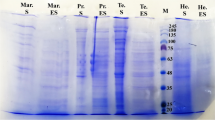Abstract
Two trials were carried out to compare the use of different enzyme-linked immunosorbent assays (ELISAs) for the detection of antibodies against Sarcoptes scabiei var. suis. In the first trial, we employed four tests and 70 selected sera from a closed pig farm with sarcoptic mange. The sera were taken from the breeding area as well as from the finishing unit and compared with skin scrapings. The SARCOPTES-ELISA 2001 yielded the most positive results (88.58%), followed by the ELISA of the National Veterinary Institute, Uppsala (70%), the Acar-Test P-ELISA (52.86%), skin scrapings (48.57%), and the CHEKIT Sarcoptest (30%). In the second trial, eight litters from infected sows were examined from weeks 1–12 of life using the CHEKIT Sarcoptest and the SARCOPTES-ELISA 2001. The presence of maternal antibodies was highest on day 7 in both ELISAs and could be detected until weeks 5–9 of life. Antibodies increased as a result of an active immune response between days 56 and 63 in the SARCOPTES-ELISA 2001 and between days 70 and 77 of life in the CHEKIT Sarcoptest. Significant differences between the first and second litters were observed.

Similar content being viewed by others
References
Alonso de Vega F, Mendez de Vigo J, Ortiz Sanchez J, Martinez-Carrasco Pleite C, Albaladejo Serrano A, Ruis de Ybanez Carnero MR (1997) Evaluation of the prevalence of sarcoptic mange in slaughtered fattening pigs in southeastern Spain. Vet Parasitol 76:203–209
Arends JJ, Stanislaw CM, Gerdon D (1990) Effects of sarcoptic mange on lactating swine and growing pigs. J Anim Sci 68:1495–1499
Bornstein S, Zakrisson G (1993) Clinical picture and antibody response in pigs infected by Sarcoptes scabiei var. suis. Vet Dermatol 4:123–131
Bornstein S, Eliasson-Selling L, Näslund K, Wallgren P (2000) Evaluation of a serodiagnostic ELISA for swine sarcoptic mange. Proceedings of the 16th IPVS Congress, Melbourne, Australia, 17–20 September 2000, p 269
Davies PR, Bahnson PB, Grass JJ, Marsh WE, Garcia R, Melancon J, Dial GD (1996) Evaluation of the monitoring of popular dermatitis lesions in slaughtered swine to assess sarcoptic mite infestation. Vet Parasitol 62:143–153
Deckert A, Nixon R, Daigenault J, Pentney P, Dewey C (2000) The evaluation.of the Bommeli ELISA Sarcoptest for Sarcoptes scabei var. suis and the prevalence of mange in Ontario, Canada. Proceedings of the 16th IPVS Congress, Melbourne, Australia, 17–20 September 2000, p 268
Dolischka A (2001) Zur Epidemiologie von Sarcoptes scabiei var. suis in einem Zuchtbetrieb und Möglichkeiten zur Kontrolle der Tilgung. Vet. med. thesis, University of Vienna
Flesjâ KI, Ulvesaeter HO (1979) Pathological lesions in swine at slaughter. Acta Vet Scand 20:498–514
Gualandi GL, Boni P, Varisco G, Paiaro E, Garcia R, Gross S (1994) Study of the prevalence of Sarcoptic mange in pigs at slaughterhouses in major swine-production areas in northern Italy. Proceedings of the 13th IPVS Congress, Bangkok, Thailand, 26–30 June 1994, p 246
Gutiérrez JF, De Vigo JM, Castellá J, Munoz E, Ferrer D (1996) Prevalence of sarcoptic mange in fattening pigs sacrificed in a slaughterhouse of northeastern Spain. Vet Parasitol 61:145–149
Hollanders W, Vercruysse J (1990) Sarcoptic mite hypersensitivity: a cause of dermatitis in fattening pigs at slaughter. Vet Rec 126:308–310
Jacobson M, Bornstein S, Wallgren P (1999) The efficacy of simplified eradication strategies against sarcoptic mange mite infections in swine herds monitored by an ELISA. Vet Parasitol 81:249–258
Kessler E, Matthes HF, Schein E, Wendt M (2003) Detection of antibodies in sera of weaned pigs after contact infection with Sarcoptes scabiei var. suis and after treatment with an antiparasitic agent by three different indirect ELISAs. Vet Parasitol 114:63–73
Kircher P, Zimmermann W (1999) Serologische Bestanduntersuchung und Sanierungsüberwachung der Sarcoptes-scabiei-var.-suis-.Infektion : eine sero-epidemiologische Studie in räudefreien und chronisch infizierten Betrieben. Schweiz Arch Tierheilkd 141:567–573
Krieger KJH, Schmitz KH (1992) Der Einfluß einer prophylaktischen Räude- und Läusebekämpfung bei Mastschweinen mit Sebacil Pour-on auf Mastleistung und Betriebsergebnis. Schweiz Arch Tierheilkd 135:247
Melancon JJ (1998) Sarcoptic mange in swine: current prevalence. Compend Cont Educ Pract Vet 20:87–95
Rambags PGM, Vesseur PC, Van der Heijden HMJF (1998) Mange (Sarcoptes scabiei var. suis) eradication programme and possibilities for certification in Dutch pig farms. Proceedings of the 15th IPVS Congress, Birmingham, England, 5–9 July 1998, p 123
Smets K, Vercruysse J (2000) Evaluation of different methods for the diagnosis of scabies in swine. Vet Parasitol 90:137–145
Van der Heijden HMJF, Rambags PGM, Elbers ARW, Van Maanen C, Hunneman WA, (2000) Validation of ELISAs for the detection of antibodies to Sarcoptes scabiei in pigs. Vet Parasitol 89:95–107
Venkatesan P, Wakelin D, (1993) ELISAs for parasitologists: lies, damned lies and ELISAs. Parasitol Today 9:228–232
Vercruysse J, Smets K, (2000) The diagnosis of swine mange: a European perspective. Proceedings of the 16th IPVS Congress, Melbourne, Australia, 17–20 September 2000, p 266
Wallgren P, Bornstein S (1997) The spread of sarcoptic mange during the fattening period revealed by development of antibodies to Sarcoptes scabiei. Vet Parasitol 73:315–324
Zimmermann W, Kircher P (1998) Serologische Bestandesuntersuchung und Sanierungsüberwachung der Sarcoptes scabiei var. suis Infektion: erste vorläufige Resultate. Schweiz Arch Tierheilkd 140:513–517
Zimmermann W, Neff F, Birrer S (2001) Serologische Bestandsuntersuchung der Sarcoptes scabiei var. suis Infektion mit Kolostralmilchproben: vorläufige Resultate. Schweiz Arch Tierheilkd 143:70–76
Acknowledgements
The authors gratefully acknowledge the support from Prof. Schein, Berlin and Dr. Bornstein, Uppsala, and also thank Dr. A. Dolischka for technical assistance.
Author information
Authors and Affiliations
Corresponding author
Rights and permissions
About this article
Cite this article
Löwenstein, M., Kahlbacher, H. & Peschke, R. On the substantial variation in serological responses in pigs to Sarcoptes scabiei var. suis using different commercially available indirect enzyme-linked immunosorbent assays. Parasitol Res 94, 24–30 (2004). https://doi.org/10.1007/s00436-004-1168-7
Received:
Accepted:
Published:
Issue Date:
DOI: https://doi.org/10.1007/s00436-004-1168-7




